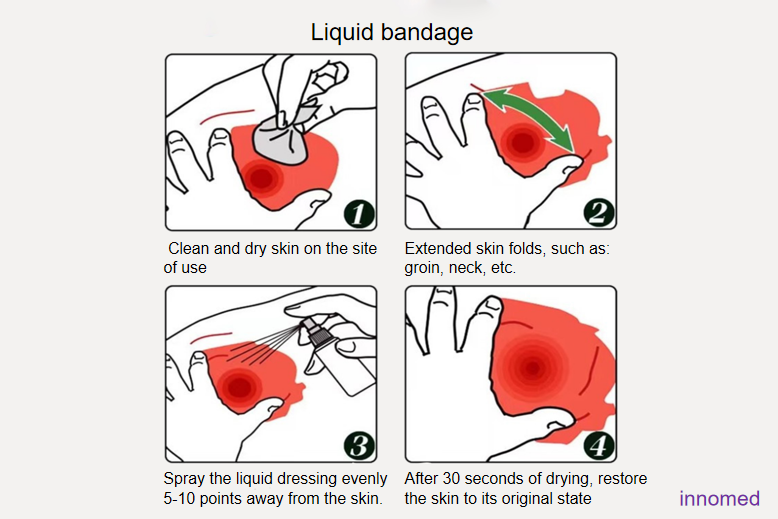What is a liquid bandage?
Liquid dressings are like the second skin of our human body. They can quickly form a transparent protective film on the skin in a spray suitable for minor superficial wounds, abrasions, and skincare.
the characteristics of liquid dressings used in superficial wounds:
Fast film formation: The product can quickly form a film within 30-60s when sprayed on the skin.
Waterproof and bacterial isolation: After the liquid dressing is formed into a film, it has good waterproofness, effectively preventing water from polluting the wound surface.
Long-lasting skincare: It is breathable after spraying on the skin and has no pulling feeling. It is gentle and safe on the skin for 24-72 hours to help the skin avoid damage.
It is used in a variety of scenarios to protect the skin:
1. Incontinence care
Incontinent dermatitis is caused by the chemical irritation of the skin caused by the involuntary overflow of urine and feces after incontinence. Traditional incontinence dermatitis care focuses on keeping local skin dry and clean. Frequent scrubbing and rinsing also increase the workload of nursing staff. The liquid dressing is sprayed on the skin surface to form a transparent protective film, which has the characteristics of anti-friction and breathability. On this basis, the combined use of stoma skincare powder can further keep the skin clean and dry and prevent chemical irritation to the skin caused by fecal water and repeated rinsing. This promotes the healing of dermatitis. The liquid dressing combined with stoma skincare powder can heal skin lesions of incontinence dermatitis, enhance the recovery effect, and reduce recurrence. Patient comfort is high. She is applying a liquid dressing after dry skin can improve the skin's resistance. At the same time, the sauce forms a protective film on the skin surface, which can block urine and feces from impregnating the skin and reduce skin friction. The liquid bandage is convenient for nursing staff to clean the patient's excrement, and the operation is simple, which can reduce the nursing workload and improve work efficiency.
2. Infant red buttocks care
One of the common skin diseases of infants is baby red buttocks, which occurs in the buttocks, groin, under the scrotum, and inner thighs; especially in the group of infants with diarrhea, the incidence rate will be higher, as we all know, the baby's skin is very delicate and sensitive. The stratum corneum has not fully developed, so the resistance is relatively poor if friction occurs. When the baby's skin is exposed to heat and humidity for a long time, it can cause inflammation of the baby's buttocks. When the symptoms are mild, there will be a red rash, and in severe cases, the baby's buttocks will fester and ooze pus. Therefore, we must pay attention to the hygiene of the baby. A little carelessness will cause infection, which will eventually lead to sepsis. In the clinical treatment of infants with red buttocks, routine washing and frequently changing to keep the baby's skin fresh and spraying with liquid dressings has an apparent curative effect on the infant's red buttocks.
3. Skin protection around the stoma
The liquid dressing and stoma skincare powder can be used together to protect the surrounding skin better. It is non-irritating, easy to operate, and convenient for nursing.
Precautions for the use of liquid dressings:
1. The skin should be clean and dry before using the product.
2. Spraying: Hold the nozzle 5-10cm away from the skin, and spray several times continuously depending on the protected area, completely covering the area that needs protection. 2-4 times/day, can always be used.
3. It can be effectively protected for 72 hours under normal circumstances. The corresponding number of times can be increased after cleaning severe patients.
4. The transparent film will fall off automatically after 2-3 days; no need to tear it off.
Aditor:kiki Jia
Date:May31,2022

 English
English عربى
عربى Español
Español русский
русский 中文简体
中文简体








